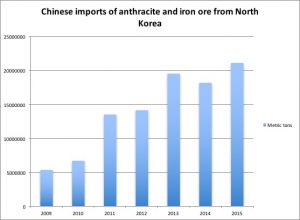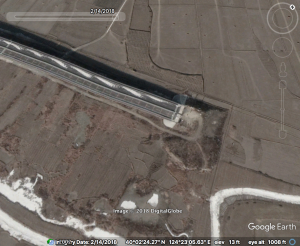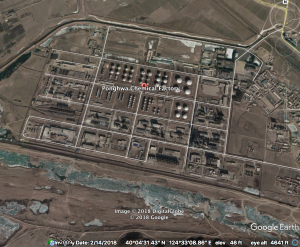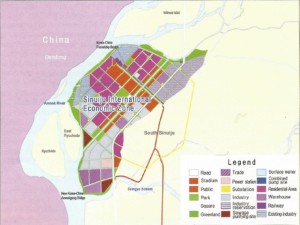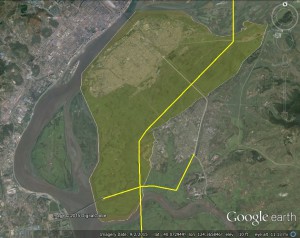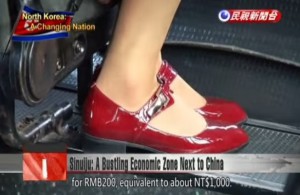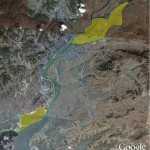
Pictured Above (Google Earth): The new PRC/DPRK economic zone: Hwanggumphyong-ri (Sindo County) and Wihwa Island (Sinuiju and Uiju Counties). See islands in Google Maps here and here.
UPDATE 13 (2011-6-14): US urges caution. According to Yonhap:
“We urge transparency, extreme caution and vigilance in any business dealings with North Korea. We urge all United Nations member states to fully implement U.N. Security Council Resolutions 1718 and 1874, which target North Korea’s continued involvement in proliferation, nuclear weapons development and procurement of luxury goods,” the White House official said on condition of anonymity.
The U.S. and South Korea have been putting economic pressure on the impoverished North, which refuses to dismantle its nuclear program and continues military threats. But China, the North’s largest benefactor, has maintained close economic ties with North Korea, prompting criticism that it is undermining U.N. sanctions on Pyongyang imposed after its nuclear and missile tests in 2006 and 2009.
UPDATE 12 (2011-6-9): Here is coverage of the groundbreaking ceremony in KCNA.
UPDATE 11 (2011-6-10): Barbara Demick, writing for the L.A. Times, highlights the low-key nature of the ground-breaking ceremonies as well as providing details of the lease agreements. According to the article:
Pyongyang publicized the ceremonies, but official Chinese news outlets did not send reporters attend and carried just brief dispatches based largely on news releases. The lack of publicity in China may reflect Beijing’s ambivalence about doing business with an unreliable neighbor and a desire to avoid international criticism for propping up a nuclear-armed country with an abysmal human rights record.
…
China reportedly signed a 50-year-lease for the 4.6-square-mile Hwanggumpyong, where a 30-minute ceremony was held Wednesday. The South Korean Yonhap news service reported that large balloons flew overhead with the slogans “Friendship between China and North Korea” and “Joint Development.” The low-lying island, south of the Chinese city of Dandong, is currently used for farmland and a North Korean military installation. A smaller island called Wihwa is also part of the deal.
The Chinese are also building a new bridge to the islands that is eventually supposed to be extended to reach to the North Korean mainland.
UPDATE 10 (2011-6-10): Caijing, which is (according to the Wall Street Journal) China’s leading finance newspaper has just published a lengthy article (in Chinese) about North Korea and states at the beginning of the article the “urgent need for internal reforms to adapt to the trend of market forces”. Here is the article.
UPDATE 9 (2011-6-9): Xinhua reports on the ground breaking ceremony:
Officials from China and the Democratic People’s Republic of Korea (DPRK) have reached a consensus to jointly develop two economic zones in the DPRK, according to a press release issued by the Chinese Ministry of Commerce on Thursday.
From Tuesday to Thursday, Chinese and DPRK officials convened in northeast China’s Liaoning and Jilin provinces for the second meeting of the Development Cooperation and Joint Steering Committee.
Their meeting concerned the development of the Rason Economic and Trade Zone and the Hwanggumphyong and Wihwa Islands Economic Zone.
The joint development of the two economic zones in the DPRK will be “government-guided, enterprise-based and market-oriented,” according to the press release.
Both sides agreed to work together and give full play to their respective advantages in the development of the economic zones, the release said.
China and the DPRK have agreed to build the economic zones into a model of Sino-DPRK economic and trade cooperation and a platform to promote economic and trade cooperation with the rest of the world, the release said.
Both sides also held launching ceremonies for several cooperative projects during the meeting, according to the press release.
The meeting was jointly presided over by Chen Deming, Chinese Minister of Commerce, and Jang Song Taek, the administrative director of the Korean Workers’ Party.
The committee held its first meeting in the DPRK’s capital of Pyongyang last November.
UPDATE 8 (2011-6-9): The Choson Ilbo reports on the Hwanggumphyong opening ceremony:
The ceremony started at 10:40 a.m. and took half an hour. Huge balloons with messages like “Friendship between China and North Korea” and “Joint Development” floated in the air above while a military brass band played. Some 300-400 people attended, a stark contrast from the ground breaking for a new bridge connecting Sinuiju in North Korea to China’s Dandong across the Apnok (or Yalu) River at the end of last year, which lasted just 10 minutes with a few dozen regional officials present. AP’s Pyongyang correspondent was allowed to cover the event.
UPDATE 7 (2011-6-9): A reader notes int the comments that it is probably incorrect to refer to this development as a “Special Administrative Region” because we have yet to see if there is any new administrative apparatus which will control the new zone. So until we see such a development I will refer to this as a “Special Economic Zone (SEZ)”.
UPDATE 6 (2011-6-7): Yonhap reports that Jang Song-thaek attended a groundbreaking ceremony on Hwanggumphyong today (Wednesday):
North Korea and China on Wednesday broke ground on a border island to develop it into an economic zone, spurring speculation that Pyongyang may embrace Chinese-style economic development to try to revive its faltering economy.
The groundbreaking ceremony came on the heels of North Korean leader Kim Jong-il’s weeklong trip to China in May to study the neighboring country’s spectacular economic development, his third trip to China in just over a year.
On Wednesday, some 1,000 people from North Korea and China, including Kim’s brother-in-law, Jang Song-thaek, and Chinese Commerce Minister Chen Deming, attended the ceremony on Hwanggumphyong Island in the Yalu River that separates the two countries.
Several dozen giant advertising balloons were floating in the air as a military brass band played festive songs, and hundreds of doves were released at the ceremony.
The messages on the balloons read “North Korea-China friendship and joint development” in a symbolic gesture for their commitment to the project.
The two sides also reportedly signed a deal on the joint development project, including lease terms on Hwanggumphyong. No details were immediately available.
UPDATE 5 (2011-6-7): KCNA announces (here and here) the establishment (and expansion) of the Special Administrative Region (SAR or SEZ):
(KCNA: 2011-6-6) DPRK Decides to Set Up Hwanggumphyong and Wihwa Islands Economic Zone
The DPRK decided to set up the Hwanggumphyong and Wihwa Islands Economic Zone in order to boost the DPRK-China friendship and expand and develop the external economic relations.
A decree of the Presidium of the Supreme People’s Assembly was promulgated on June 6 in this regard.
According to it, Hwanggumphyong-ri, Sindo County, Sangdan-ri, Hadan-ri and Taji-ri, Sinuiju City and Soho-ri, Uiju County of North Phyongan Province shall belong to the zone.
The sovereignty of the DPRK shall be exercised in the zone.
The development of the zone shall start from the Hwanggumphyong district.
and…
(KCNA: 2011-6-7) Hwanggumphyong and Wihwa Islands Economic Zone to Be Set Up
The Japanese Tokyo Shimbun Tuesday released the following report titled “Close to setting up economic zone on DPRK-China border:”
The Presidium of the Supreme People’s Assembly of the DPRK Monday promulgated a decree on setting up the Hwanggumphyong and Wihwa Islands Economic Zone in the border with China. It was reported that the sovereignty of the DPRK would be exercised in the zone and the development of the zone would start from the Hwanggumphyong district.
Both Hwanggumphyong and Wihwa Islands are within the territory of the DPRK along the River Amnok flowing along the DPRK-China border. It was basically agreed to develop Hwanggumphyong by the joint efforts of the DPRK and China. A ground-breaking ceremony is expected to take place within one or two days.
The project for building the DPRK-China Amnokgang Bridge which started at the end of last year is making brisk headway on the river. It seems that a discussion on the above-said zone was held during the China visit by General Secretary Kim Jong Il in May and it is likely to put greater impetus to economic cooperation between the DPRK and China and development of the border area with the decision as an occasion.
The SPA Presidium of the DPRK, explaining the reason for setting up the economic zone, said it was to boost the traditional DPRK-China friendship and expand and develop external economic relations.
South Korean CBS released similar news on the same day.
In a separate note, it is nice to hear the construction on the second Yalu River bridge is “making brisk headway”. The north Korean media has not reported on the bridge in some time. The bridge does not run through any of the newly created Special Economic Zone.
UPDATE 4 (2011-6-5): According to the Donga Ilbo, the groundbreaking ceremony is supposed to take place tomorrow (Tuesday). On Thursday a groundbreaking ceremony is scheduled for Rason.
UPDATE 3 (2011-5-30): The groundbreaking ceremony was cancelled. It is unclear when development will begin. According to the Choson Ilbo,
There has been no official comment from China, but a ground-breaking ceremony for the development scheduled for Saturday has been cancelled, apparently because China had second thoughts. “Since last year, I’ve had business officials from other regions like Tianjin and Qingdao, asking me whether there’s any vacant office spaces for rent,” said a business owner in Dandong.
But people in Dandong have not lost all hope of potential development of the area. One Chinese businessman who has traded with North Korea since the 1990s, said, “Business projects with North Korea usually take a long time to materialize, and talk of developing Hwanggumphyong and Wihwa islands have been around for a long time, so I feel they will happen someday.”
Other major projects are already under way in Dandong. The Chinese city plans to build a new city in the Langtou area to house 200,000 people by 2020. A bank building and high-rise apartments have already sprung up in the area, which was a barren tract of land just three years ago. And a new bridge is being built linking Langtou with the North Korean border town of Ryongchon across the [Amnok] River.
UPDATE 2 (2011-5-10): Development of Hwanggumphyong Island is reported to begin this month (May 2011).
According to the AFP:
North Korea and China will start work on developing a river island on their border this month, a report said Tuesday, amid an international drive to coax Pyongyang back to nuclear disarmament talks.
The two countries plan to hold a groundbreaking ceremony on May 28 for development of the island on the Yalu River, the South’s Yonhap news agency said.
Pyongyang has reportedly worked out a special law to set up a free trade zone on the island, which is separated by a narrow waterway from the Chinese city of Dandong.
…
The two sides have agreed to turn the island into a base for logistics, tourism and manufacturing that would be linked to China’s industrial complex to be built in Dandong, Yonhap said.
There is still no sign that Wihwa Island is receiving any special development.
UPDATE 1 (2011-3-30): Huangjinbing Island (mentioned below) is the Chinese name of Hwanggumphyong Island (Hwanggumpyong, Hwangkupyong, 황금평: 39.961121°, 124.316044°). The Chinese recently built a fence around this island.
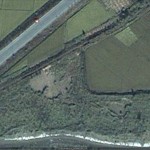
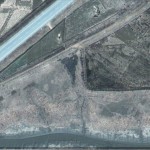
Using Google Earth (39.964363°, 124.288470°) we can see both before and after satellite images of the fence construction which separates the DPRK’s island territory from the PRC’s. Dates: 2009-10-2 (Left/Before), 2010-4-5 (Right/After)
According to the Telegraph:
Fences more than 13ft [3.962 m] high, topped with barbed wire, are now being erected along an eight-mile stretch of the Yalu river around the Chinese city of Dandong. This is a popular escape point for North Korea refugees seeking food or better lives, Korea’s Yonhap news agency reported.
“It’s the first time such strong border fences are being erected here. Looks like it is related to the unstable situation in North Korea,” a resident said of the work which began last November but is ongoing.
Previously the border was only marked by a 10ft-high fence which “anybody could cross if they really wanted”, the resident added.
Fears for the stability of North Korea have been heightened in recent weeks with reports of a growing food crisis following the severest winter in 60 years and an outbreak of foot-and-mouth disease that has hit the oxen that are still mainly used to plough the North’s fields.
This week, in a highly unusual step, foreign aid agencies based in Pyongyang issued a joint statement warning that 6 million North Koreans now need urgent food aid because crops of potatoes, wheat and barley have all failed.
As an aside, at least one report claims this island has been leased to China.
Read the full Telegraph story below:
China builds higher fences over fears of instability in North Korea
Telegraph
Peter Foster
3/30/2011
ORIGINAL POST (2010-2-25): In September 2002 the North Korean government announced the Siuiju Special Administrative Region/ Special Economic Zone. It did not end well. The idea of implementing a Sinuiju SAR/SEZ, however, has never faded away–though it has taken different forms.
Sunuiju Version 1: The initial vision of the city, under a Yang Bin administration, was the creation of a very liberal and independent territory which would supposedly be free of Pyongyang’s dictates in exchange for tax revenue. The Hong Kong-style “Basic Law” can be found here.
Sinuiju Version 2: In March of 2007 the North Koreans decided to move the SAR/SEZ territory out of the Sinuiju city center on two Islands in the Tumen River: Bidan and Wihwa.
Sinuiju Version 3: In August 2007 creation of a special zone had reportedly already begun, however, this time the project is located in the Sinuiju city center (not remote islands).
Sinuiju Version 4: In January 2009 the Yomiuri Shimbum reported that the SAR/SEZ had once again moved out to Wihwa Island.
Today Adam Cathcart emailed me a report in the Huanqiu Shibao featuring the following statement by a PRC foreign ministry spokesman :
环球时报记者段聪聪报道 2月25日,中国外交部发言人秦刚在例行记者会上就中国企业有可能获准开发两个朝鲜岛屿的事情表态:“不要混淆联合国制裁和两国正常的经贸往来。” Global Times reporter Duan Congcong reports on Feb. 25: Chinese Foreign Ministry Spokesperson Qin Gang, at a press conference, stated [the Ministry’s] position on the situation of the possibility of Chinese enterprises obtaining permission to start business on two Korean islands : “Don’t confuse U.N. Sanctions with normal bilateral trade dealings.”
据报道,朝鲜为了吸引外国投资,决定将位于中朝边境临近辽宁丹东市的威化岛和黄金屏岛定为自由贸易区域,交由中国企业进行开发。两岛的投资规模分别为5亿和3亿美元。秦刚表示,不要混淆联合国制裁和两国之间正常的经贸往来与合作。对朝鲜实施制裁,联合国的有关决议有明确的规定,规定了制裁的项目。而报道中提到的 项目属于中朝之间正常的经贸往来,并不违反联合国规定. According to the report, North Korea is attracting foreign investment, and has decided to establish a free trade zone on the islands of Weihua [威化岛] and Huangjinbing [黄金屏岛] in the Sino-Korean border area of Liaoning’s Dandong city. The dimensions of the two islands’ total investment will total 500 and 300 million U.S. dollars, respectively. Qin Gang stated that it wasn’t necessary to confuse UN sanctions with normal bilateral economic dealings and cooperation. Regarding the implementation of sanctions on North Korea, the related United Nations resolutions are very clear in their stipulations of the project. But, the report noted, projects referring to inclusion of normal bilateral trade between China and North Korea are not forbidden by the UN stipulations.
据报道,朝鲜政府高层就比邻中国丹东的边境地区建立特别经济区方案正在进一步细化过程当中。参与此次朝鲜岛屿开发的中国丹东华商海外投资公司将组团赴朝就具体合作意向进行最后敲定。 According to the report, high officials in North Korea’s government nieghboring China’s Dandong border area are currently moving in a detailed way with establishing this special economic zone. Participating in the development of this North Korean islands are Dandong Huashang Overseas Investment Corp. which will organize and send a delegation to North Korea in order to cooperate and move forward with final resolution.
I will call this “Sinuiju SAR: Version 5.” Wihwa Island is back, but Bidan Island has been replaced by “Huangjinbing Island.”
Additional Information
1. The Dandong Huashang Overseas Investment Corp. web page is here. (again, h/t Adam)
2. China has also reportedly approved the creation of a trade zone on its side of the North Korean border.

